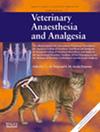Pharmacodynamics and pharmacokinetics of rocuronium in sevoflurane-anesthetized Thoroughbred horses
IF 1.9
2区 农林科学
Q2 VETERINARY SCIENCES
引用次数: 0
Abstract
Objective
To investigate the pharmacodynamics and pharmacokinetics of rocuronium administered by bolus injection to sevoflurane-anesthetized horses.
Study design
Prospective, experimental, crossover study.
Animals
Five healthy adult Thoroughbred horses (body mass 368–470 kg, three females and two males).
Methods
Each horse was anesthetized twice with sevoflurane and assigned to be administered rocuronium bromide intravenously: 0.2 mg kg–1 (R02) or 0.4 mg kg–1 (R04). There was a minimum 2 week washout period between experiments. During anesthesia, the peroneal nerve was stimulated (train-of-four) and neuromuscular function was assessed with acceleromyography. Plasma rocuronium concentrations were measured using liquid chromatography–tandem mass spectrometry. Pharmacodynamic and pharmacokinetic data are presented as mean ± standard deviation and were statistically compared between R02 and R04 with a Student’s paired t-test. Significance was set at p < 0.05.
Results
Complete neuromuscular blockade was observed in all horses. The duration of action was significantly shorter for R02 (42.5 ± 11.2 minutes) than for R04 (67.0 ± 17.8 minutes, p = 0.003). Plasma concentrations of rocuronium showed a biphasic elimination pattern. Systemic clearance was significantly higher for R04 (2.12 ± 1.15 mL minute–1 kg–1) than for R02 (1.07 ± 0.46 mL minute–1 kg–1, p = 0.034). Mean residence time was significantly shorter for R04 (109 ± 73.1 minutes) than for R02 (183 ± 64.6 minutes, p = 0.015).
Conclusions and clinical relevance
Rocuronium induced complete neuromuscular blockade with both R02 and R04, and exhibited a dose-dependent duration of action. Significantly higher systemic clearance and shorter mean residence time for the high dose (R04) were observed compared with the low dose (R02). The prolonged clearance of rocuronium in horses contributed to its extended duration of action in this species.
罗库溴铵在七氟醚麻醉的纯种马体内的药效学和药代动力学。
目的:研究罗库溴铵在七氟醚麻醉马体内的药效学和药动学。研究设计:前瞻性、实验性、交叉研究。动物:5匹健康的成年纯种马(体重368-470公斤,3母2公)。方法:用七氟醚麻醉每匹马两次,分别静脉注射罗库溴铵:0.2 mg kg-1 (R02)或0.4 mg kg-1 (R04)。两次试验之间至少有2周的洗脱期。麻醉期间,腓神经被刺激(四列),神经肌肉功能用加速肌图评估。采用液相色谱-串联质谱法测定血浆罗库溴铵浓度。药效学和药代动力学数据以均数±标准差表示,R02和R04采用Student’s配对t检验进行统计学比较。p < 0.05为显著性。结果:所有马均出现神经肌肉完全阻断。R02组的作用时间(42.5±11.2分钟)明显短于R04组(67.0±17.8分钟,p = 0.003)。罗库溴铵血药浓度呈双相消除型。R04组全身清除率(2.12±1.15 mL min -1 kg-1)显著高于R02组(1.07±0.46 mL min -1 kg-1, p = 0.034)。R04组平均停留时间(109±73.1 min)显著短于R02组(183±64.6 min), p = 0.015。结论及临床意义:罗库溴铵可诱导R02和R04完全神经肌肉阻断,且作用时间呈剂量依赖性。与低剂量(R02)相比,高剂量(R04)观察到更高的全身清除率和更短的平均停留时间。罗库溴铵在马体内的长时间清除有助于延长其在该物种中的作用时间。
本文章由计算机程序翻译,如有差异,请以英文原文为准。
求助全文
约1分钟内获得全文
求助全文
来源期刊

Veterinary anaesthesia and analgesia
农林科学-兽医学
CiteScore
3.10
自引率
17.60%
发文量
91
审稿时长
97 days
期刊介绍:
Veterinary Anaesthesia and Analgesia is the official journal of the Association of Veterinary Anaesthetists, the American College of Veterinary Anesthesia and Analgesia and the European College of Veterinary Anaesthesia and Analgesia. Its purpose is the publication of original, peer reviewed articles covering all branches of anaesthesia and the relief of pain in animals. Articles concerned with the following subjects related to anaesthesia and analgesia are also welcome:
the basic sciences;
pathophysiology of disease as it relates to anaesthetic management
equipment
intensive care
chemical restraint of animals including laboratory animals, wildlife and exotic animals
welfare issues associated with pain and distress
education in veterinary anaesthesia and analgesia.
Review articles, special articles, and historical notes will also be published, along with editorials, case reports in the form of letters to the editor, and book reviews. There is also an active correspondence section.
 求助内容:
求助内容: 应助结果提醒方式:
应助结果提醒方式:


